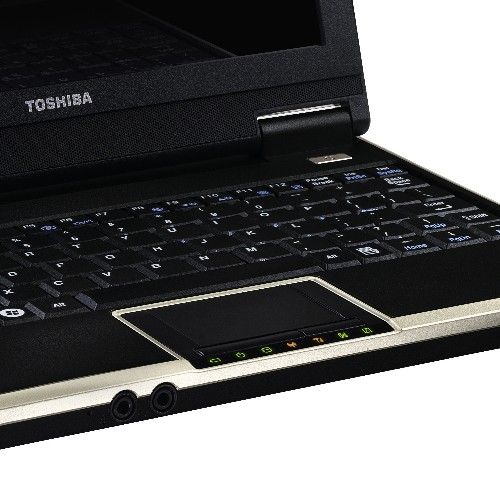With over 20 machines available, it's fair to say the netbook party is in full swing, but it's still missing one or two of the big players. Toshiba is no longer one of them, having recently launched the NB100, and it's definitely a case of better late than never.
Our quick take
With its mini-me styling, comprehensive software suite and easy to use operating system, it’s impossible to dislike the NB100. Now some of its rivals are concentrating solely on larger, 10.2-inch Netbooks, it’s a refreshing change to see a return to the original form-factor, and this is a machine you can truly take anywhere.
It’s worth having a go if you can, however, as some users will definitely find the small keyboard too cramped. Other than that, it’s an excellent effort, and one that comes highly recommended.

Toshiba NB100-11R notebook - 4.0 / 5
| FOR | AGAINST |
|---|---|
|
|
The NB100 is an 8.9-inch Netbook weighing in at 1.1kg, and looks little larger than the diminutive Eee PC 701. Where the Eee, and many of its compatriots, look toy-like - earning scorn from those with shiny and ultra-expensive ultraportables - the tiny Toshiba looks like a bona-fida miniature laptop.
The back of the screen is glossy black - look very closely and you'll see it features subtle flecks of blue. The inside of the machine is a mix of matt black plastics with gun-metal grey highlights. The overall look is simple, and similar in style to larger Toshiba laptops.
Part of the reason it looks better than most netbooks is because the display stretches right to the edges of the surrounding plastics - where many of its rivals feature thick and unsightly bezels around their screens.
The panel itself is excellent. The 1024 x 600 pixel resolution is standard for a netbook, but at the lower end of the size spectrum it's perfectly adequate. The panel features a glossy finish which results in vibrant and deep colours, helped by LED backlighting.
Unsurprisingly considering the NB100’s size, the keyboard is a love it or loath it affair. It's small, similar in style to the original Eee PC 701's, but a little bit easier to use. Those with large hands should definitely try it first, but once you get accustomed to it it's no worse than most netbooks.
The touchpad takes up most of the space beneath the keyboard, leaving little space for the mouse buttons. They're predictably small, but we didn't have any problem with them. The pad itself is ultra-responsive, making the most of its teeny dimensions. Toshiba has also crammed in a scroll bar on the right, and the whole lot works really rather well.
One of the most impressive features is the interface - provided you opt for the Linux OS rather than Windows XP. The OS is a Toshiba-tweaked version of Ubuntu Linux, and it's good. The semi-transparent menus offer more than a hint of Windows Vista in style, but without the huge drain on resources, and it's a world ahead of the intuitive but simple-looking menus found in its rivals.
Those willing to abandon their prejudices about Linux, and the geektastic connotations, will find a comprehensive suite of built-in applications, all compatible with the software you're already accustomed to. PDFs, Word, Excel and PowerPoint files can all be accessed with ease, and it represents huge value for money in comparison to the more expensive XP model.
The use of Linux also means it flies in performance terms, the standard 1.6GHz Intel Atom processor coping without trouble. The 512MB of memory is also adequate for most uses. Storage space is provided in the form of a traditional mechanical hard drive - it’s not as robust or power-efficient as a flash drive, but it does offer a more capacious 80GB.
Despite the bulky battery sticking out of the rear of the machine, battery life was merely average, at around 3 hours. That said, Toshiba is keen to make an example of the battery location being part of the design - and the fact it protrudes makes it easier to grip with a single hand. We’re not so sure - it looks to us more like there’s simply no space left to put a battery of that size.
Features include an integrated webcam, three USB ports, a multi-format card reader and a VGA-out port. 802.11b/g Wi-Fi and an Ethernet adapter are also built-in as standard.
To recap
With netbooks increasing in size and price, it's nice to see a return to the 8.9-inch form factor, and Toshiba has done it better than most
